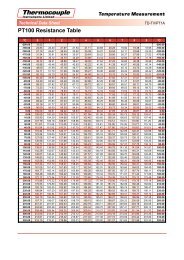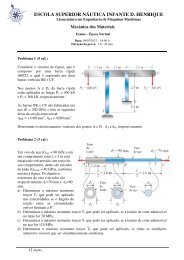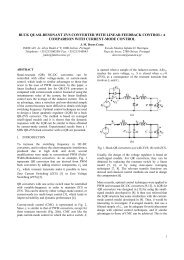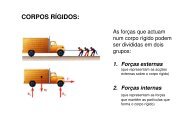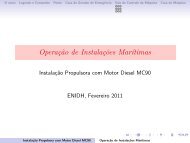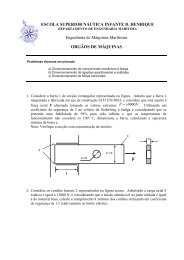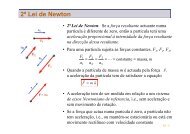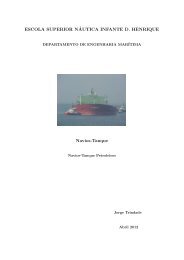Textos de Apoio (pdf)
Textos de Apoio (pdf)
Textos de Apoio (pdf)
Create successful ePaper yourself
Turn your PDF publications into a flip-book with our unique Google optimized e-Paper software.
Basic Principles of Ship Propulsion<br />
Introduction<br />
For the purpose of this paper, the term<br />
“ship” is used to <strong>de</strong>note a vehicle employed<br />
to transport goods and persons<br />
from one point to another over water.<br />
Ship propulsion normally occurs with<br />
the help of a propeller, which is the<br />
term most wi<strong>de</strong>ly used in English, although<br />
the word “screw” is sometimes<br />
seen, inter alia in combinations such as<br />
a “twin-screw” propulsion plant.<br />
Today, the primary source of propeller<br />
power is the diesel engine, and the power<br />
requirement and rate of revolution very<br />
much <strong>de</strong>pend on the ship’s hull form<br />
and the propeller <strong>de</strong>sign. Therefore, in<br />
or<strong>de</strong>r to arrive at a solution that is as<br />
optimal as possible, some general<br />
knowledge is essential as to the principal<br />
ship and diesel engine parameters<br />
that influence the propulsion system.<br />
This paper will, in particular, attempt to<br />
explain some of the most elementary<br />
terms used regarding ship types,<br />
ship’s dimensions and hull forms and<br />
clarify some of the parameters pertaining<br />
to hull resistance, propeller conditions<br />
and the diesel engine’s load<br />
diagram.<br />
On the other hand, it is consi<strong>de</strong>red beyond<br />
the scope of this publication to<br />
give an explanation of how propulsion<br />
calculations as such are carried out, as<br />
the calculation procedure is extremely<br />
complex. The rea<strong>de</strong>r is referred to the<br />
specialised literature on this subject, for<br />
example as stated in “References”.<br />
Scope of this Paper<br />
This paper is divi<strong>de</strong>d into three chapters<br />
which, in principle, may be consi<strong>de</strong>red as<br />
three separate papers but which also,<br />
with advantage, may be read in close<br />
connection to each other. Therefore,<br />
some important information mentioned in<br />
one chapter may well appear in another<br />
chapter, too.<br />
Chapter 1, <strong>de</strong>scribes the most elementary<br />
terms used to <strong>de</strong>fine ship sizes<br />
and hull forms such as, for example,<br />
the ship’s displacement, <strong>de</strong>adweight,<br />
<strong>de</strong>sign draught, length between perpendiculars,<br />
block coefficient, etc.<br />
Other ship terms <strong>de</strong>scribed inclu<strong>de</strong> the<br />
effective towing resistance, consisting<br />
of frictional, residual and air resistance,<br />
and the influence of these resistances<br />
in service.<br />
Chapter 2, <strong>de</strong>als with ship propulsion<br />
and the flow conditions around the propeller(s).<br />
In this connection, the wake<br />
fraction coefficient and thrust <strong>de</strong>duction<br />
coefficient, etc. are mentioned.<br />
The total power nee<strong>de</strong>d for the propeller<br />
is found based on the above effective<br />
towing resistance and various<br />
propeller and hull <strong>de</strong>pen<strong>de</strong>nt efficiencies<br />
which are also <strong>de</strong>scribed. A summary<br />
of the propulsion theory is shown<br />
in Fig. 6.<br />
The operating conditions of a propeller<br />
according to the propeller law valid for<br />
a propeller with fixed pitch are <strong>de</strong>scribed<br />
for free sailing in calm weather, and<br />
followed up by the relative heavy/light<br />
running conditions which apply when<br />
the ship is sailing and subject to different<br />
types of extra resistance, like fouling,<br />
heavy sea against, etc.<br />
Chapter 3, elucidates the importance<br />
of choosing the correct specified MCR<br />
and optimising point of the main engine,<br />
and thereby the engine’s load diagram<br />
in consi<strong>de</strong>ration to the propeller’s <strong>de</strong>sign<br />
point. The construction of the relevant<br />
load diagram lines is <strong>de</strong>scribed in <strong>de</strong>tail<br />
by means of several examples. Fig. 24<br />
shows, for a ship with fixed pitch propeller,<br />
by means of a load diagram, the<br />
important influence of different types of<br />
ship resistance on the engine’s continuous<br />
service rating.<br />
3


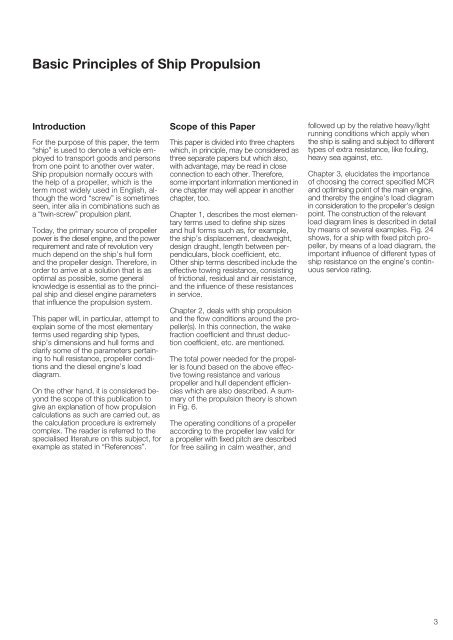
![Conceitos transmissao de dados .Sinais[.pdf]](https://img.yumpu.com/50982145/1/190x146/conceitos-transmissao-de-dados-sinaispdf.jpg?quality=85)
![Packages e interfaces[.pdf]](https://img.yumpu.com/50629553/1/190x134/packages-e-interfacespdf.jpg?quality=85)
